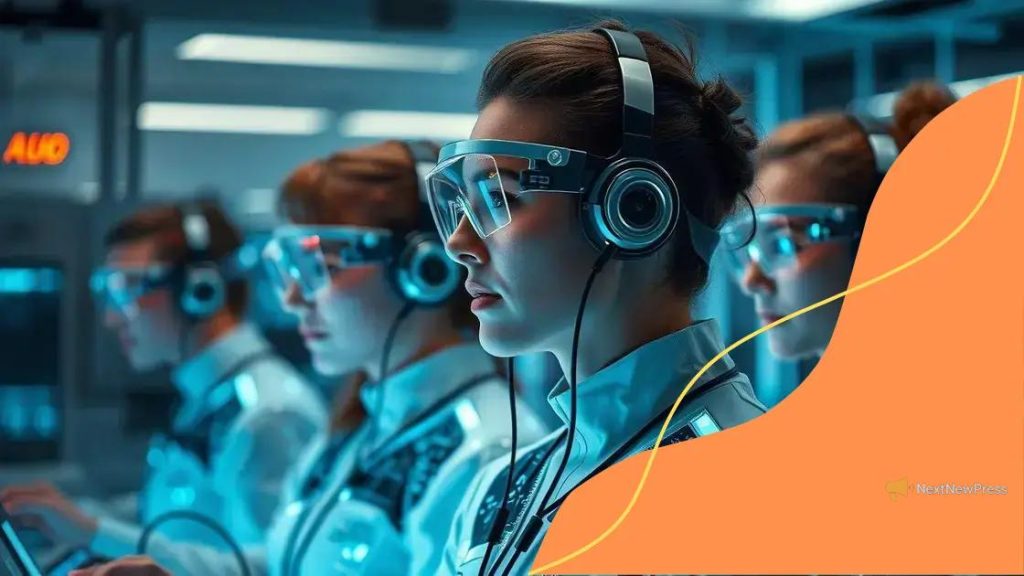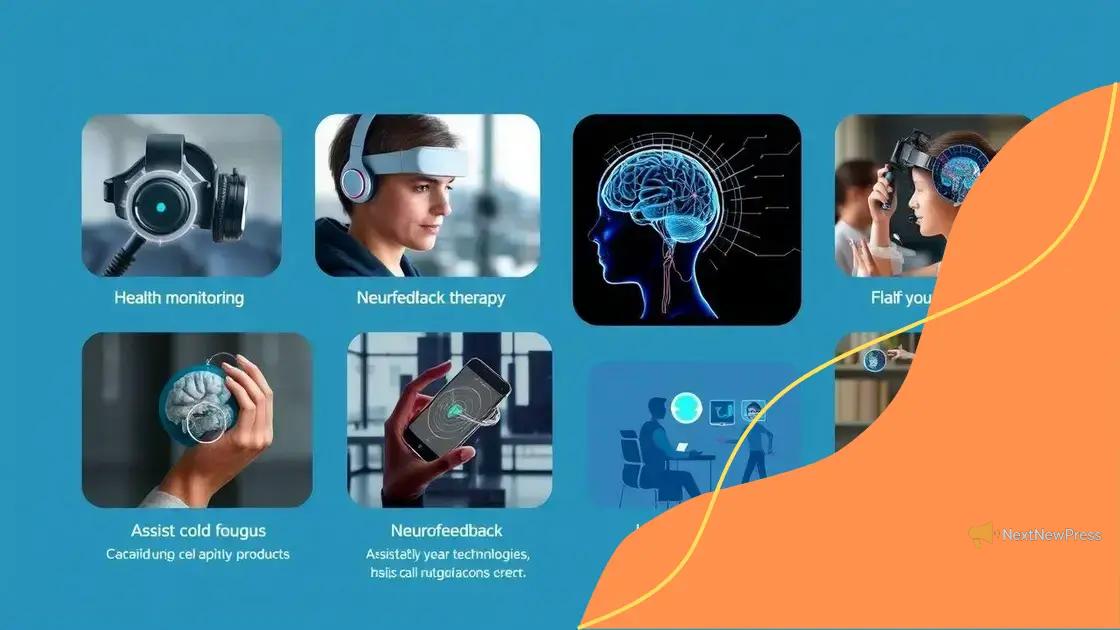Developments in human-computer interaction and neurotechnology

Developments in human-computer interaction and neurotechnology are leading to more intuitive user experiences, enhanced communication through brain-computer interfaces, and increasing accessibility in daily technologies.
Developments in human-computer interaction and neurotechnology are reshaping how we engage with machines. Have you ever wondered how these innovations affect your daily interactions with technology? Let’s dive into what’s happening.
Understanding human-computer interaction
Understanding human-computer interaction is essential as technology becomes a bigger part of our lives. It studies how people interact with computers and aims to improve these interactions. This field combines design, psychology, and computing.
Importance of Human-Computer Interaction
By studying human-computer interaction, we can create systems that are easier to use. Good design can make technology more accessible to everyone. It also helps reduce errors and increases user satisfaction.
Key Aspects
- User experience: How users feel when interacting with technology.
- Accessibility: Ensuring everyone can use technology, regardless of ability.
- Usability: Making systems that are simple and pleasant to use.
- Feedback: Providing users with clear responses to their actions.
Innovations in this area are rapid. For example, intuitive interfaces like touch screens make applications more user-friendly. Moreover, voice recognition software allows users to interact hands-free, offering convenience and safety. These developments show how understanding user needs is crucial to designing effective systems.
The evolution of human-computer interaction also considers the emotional aspect of technology use. Engaging users emotionally can enhance their overall experience. By designing not just for function but also for feeling, developers can create more meaningful connections with users.
Future Directions
The future of human-computer interaction looks promising as new technologies emerge. With advancements like virtual reality (VR) and augmented reality (AR), users can interact with digital content in immersive ways. As these technologies develop, they will transform how we perceive and engage with information.
As we continue to explore this dynamic field, it is important to remember that effective communication between humans and computers relies on empathy, creativity, and a deep understanding of user behaviors. The advancements we make will shape the way we connect with technology in our everyday lives.
Key advancements in neurotechnology
Key advancements in neurotechnology are transforming the landscape of healthcare and human interaction with technology. These breakthroughs enable us to better understand and manipulate the brain’s functions, opening new pathways to treatment and enhancement.
Brain-Computer Interfaces
One of the most significant advancements is in brain-computer interfaces (BCIs). These devices allow direct communication between the brain and external systems. BCIs are particularly valuable for individuals with disabilities, as they can assist with movement and communication.
Neuroprosthetics
Neuroprosthetics represent another important area of development. Devices like cochlear implants and retinal implants are helping restore sensory functions. These technologies rely on implanting electrodes in specific areas of the nervous system, helping individuals regain lost capabilities.
- Cochlear implants improve hearing by stimulating the auditory nerve.
- Retinal implants can restore partial vision for people with retinal degeneration.
- Experimental devices aim to restore limbs’ functions via direct brain commands.
- Neurostimulators help manage chronic pain by altering nerve activity.
Moreover, the research into neurotechnology is expanding rapidly, with tools like functional MRI and EEG becoming essential in understanding brain activity. These tools provide insights into how we think, feel, and behave, paving the way for innovative treatments for mental health conditions.
Applications in Mental Health
Applications of neurotechnology also extend to mental health. Techniques such as transcranial magnetic stimulation (TMS) are increasingly effective for conditions like depression and anxiety. These non-invasive treatments provide a new avenue for patients who have not responded well to traditional therapies.
As we look ahead, the field of neurotechnology promises to continue evolving. Ongoing research aims to enhance cognitive functions, improve learning, and even facilitate communication through thought alone. The potential applications are vast, and the impact on individuals’ lives could be profound.
Applications of neurotechnology in daily life

Applications of neurotechnology in daily life are becoming increasingly common, affecting various aspects of how we live, work, and interact. These innovations enhance personal experiences and improve health outcomes, showcasing how technology closely connects with our everyday activities.
Health Monitoring
One significant application is in health monitoring. Wearable devices equipped with neurotechnological features can track brain activity, sleep patterns, and stress levels. For example, smartwatches and fitness bands help users stay aware of their mental health.
Neurofeedback Therapy
Neurofeedback therapy uses real-time displays of brain activity to teach self-regulation of brain function. This approach allows individuals to gain control over cognitive states, which can improve focus and reduce anxiety. As people practice this technique, they may find themselves better equipped to handle daily stressors.
- Helps in managing ADHD by training attention.
- Aids in treating anxiety disorders through better emotional control.
- Enhances cognitive functions, like memory and focus.
- Promotes relaxation and stress relief techniques.
In addition, neurotechnology finds uses in education. Learning applications that adapt to the user’s mental state are emerging. These apps can change difficulty levels and techniques based on real-time feedback from brain activity, supporting more personalized learning experiences.
Assistive Technologies
Assistive technologies utilize neurotechnology to help individuals with disabilities lead more independent lives. For instance, devices that interpret brain signals can allow users to control computers or robotic limbs with their thoughts. This advancement opens new possibilities for individuals with mobility impairments, enabling them to regain some control over their environment.
Moreover, the integration of neurotechnology in entertainment, such as immersive video games, enhances user engagement. These experiences can adapt based on users’ emotional reactions, resulting in deeper interactions and enjoyment.
Challenges in human-computer interaction
Challenges in human-computer interaction present various obstacles as technology continues to integrate into our daily lives. Understanding these challenges is essential for creating better interfaces and improving user experiences.
Usability Issues
One major challenge is usability. Users often struggle with complex interfaces that are not intuitive. When a system is difficult to navigate, it can lead to frustration and decreased efficiency. Designers must prioritize clarity and simplicity in their creations.
Accessibility Considerations
Accessibility is another crucial challenge. Devices need to be usable by people with diverse abilities, including those with visual or motor impairments. Adapting technology to meet these needs requires innovative design solutions that ensure inclusivity.
- Screen readers for visually impaired users.
- Voice recognition for hands-free control.
- Touch interfaces that accommodate limited motor skills.
- Customization options for diverse user preferences.
Furthermore, cognitive load plays a significant role in human-computer interaction. When too much information is presented at once, users can become overwhelmed and make mistakes. It’s vital to present data thoughtfully to avoid taxing the user’s brain.
Privacy and Security Concerns
Privacy and security are pressing challenges as well. Users are often hesitant to interact with systems that do not protect their personal information. Fear of data breaches can result in reluctance to engage fully with technology. Creating secure systems while maintaining user trust is a delicate balance.
Finally, the rapid pace of technological change creates challenges for both users and developers. As new tools and systems emerge, keeping up with advancements can be daunting. Training users to adapt to these technologies is essential for successful implementation.
Future trends in human-computer interaction and neurotechnology
Future trends in human-computer interaction and neurotechnology are set to redefine how we engage with technology. As advancements continue, the synergy between these fields will create more intuitive and personalized experiences for users.
Integration of AI and Machine Learning
One of the most promising trends is the integration of artificial intelligence (AI) and machine learning into human-computer interaction. These technologies enable systems to learn from user behavior, adapting interfaces to fit individual needs. For example, AI can analyze how users interact with applications and suggest improvements in real time.
Immersive Technologies
Immersive technologies, like virtual reality (VR) and augmented reality (AR), are also becoming more prevalent. These technologies create engaging environments for users, allowing for hands-on experiences. In education, VR can simulate real-world scenarios, enhancing learning. In gaming, AR can blend the digital and physical worlds, providing new ways to play.
- Enhanced training simulations in healthcare and engineering.
- Interactive gaming experiences that change based on user input.
- Augmented reality applications for retail, allowing users to visualize products in their space.
- Virtual environments for remote work collaboration, making teamwork more effective.
Moreover, advancements in neurotechnology are paving the way for groundbreaking applications. Brain-computer interfaces are likely to become more sophisticated, enabling seamless communication between the brain and devices. This will allow users to control technology with thought alone, making interactions smoother and more efficient.
Focus on User-Centric Design
A growing emphasis on user-centric design will shape the future of human-computer interaction. Developers will prioritize understanding user experiences and addressing their needs. This shift will drive innovations that are not only functional but also enjoyable.
As we look toward the future, ethical considerations around neurotechnology will become increasingly important. Safeguards will need to be put in place to protect user data and privacy. This ensures that advancements benefit everyone while maintaining trust between users and technology.
The future of human-computer interaction and neurotechnology looks bright and full of potential. As AI, immersive technologies, and user-centric designs continue to evolve, they will reshape our interactions with technology. With advancements like brain-computer interfaces, we will face exciting possibilities for seamless communication and enhanced lives. However, it is essential to address privacy and ethical concerns as we move forward. Through thoughtful development, we can ensure that these innovations benefit everyone and create a more connected world.
FAQ – Frequently Asked Questions about Human-Computer Interaction and Neurotechnology
What is human-computer interaction?
Human-computer interaction (HCI) is the study of how people interact with computers and technology, focusing on designing user-friendly interfaces.
What are the benefits of neurotechnology?
Neurotechnology enhances communication between the brain and devices, improving accessibility and personalizing user experiences, especially in health care.
How can AI improve human-computer interaction?
AI can analyze user behavior and preferences to create personalized experiences, making interactions more intuitive and efficient.
What challenges does neurotechnology face?
Challenges include ensuring user privacy, accessibility for all individuals, and addressing ethical concerns related to brain data.





